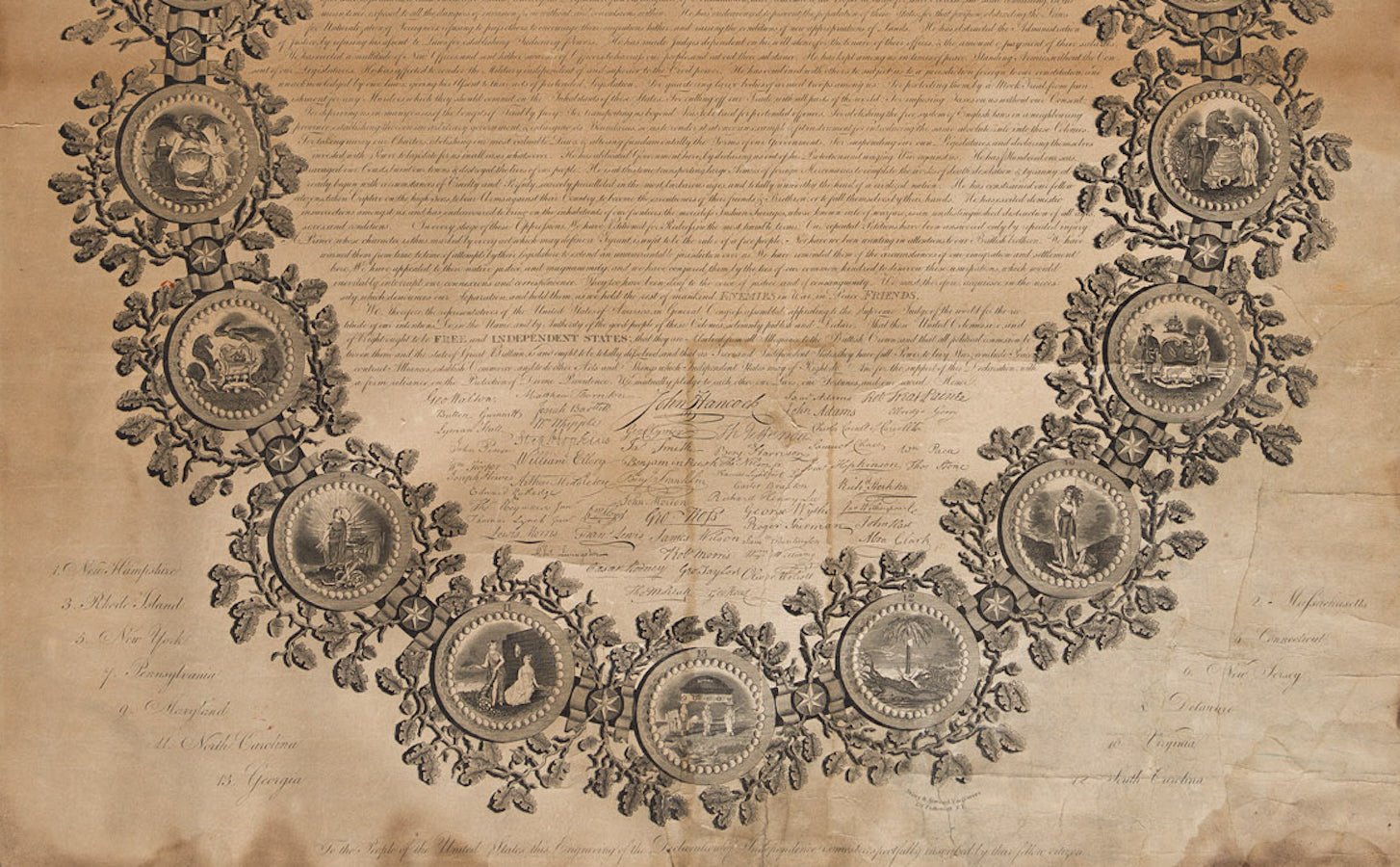






"The Declaration of Independence" Broadside, Published by Phelps & Ensign, circa 1841
Presented is an ornamental engraved broadside of the Declaration of Independence. The print was designed by William Woodruff, engraved by Story & Atwood, and published by Phelps and Ensign in New York, in 1841-43.
The composition is oval in shape, with the top formed by an amassing of draped spears and trumpets, surmounted by an eagle clutching arrows and laurel leaves in its talons. The text of the Declaration of Independence is engraved in a uniform round hand, with decorative emphasis given to the first two lines of the document, engraved in ornamental script. The Declaration’s signatures are engraved in facsimile. The complete text of the Declaration is encircled by a vine border, punctuated with the seals of the thirteen original states and six pointed stars. The state seals are identified in the lower margins. At top is a bust portrait of General George Washington, engraved by Stephen Gimber, with bust portraits of Jefferson and Adams on each side.
The line, “Story Atwood Engravers, 151 Fulton St., N.Y.,” is in the bottom center margin, followed by an engraved dedication, “To the People of the United States this Engraving of the Declaration of Independence is most respectfully inscribed by their fellow citizen, Wm. Woodruff.” At the bottom is the copyright line, which reads, “Published by Phelps and Ensign, New York.”
The Declaration of Independence is the foundational document of the United States and has been printed many times since its original publication in 1776. First published as broadsides, then as an essential addition to any volume of laws, it is a basic work in the American canon.
Following the War of 1812, Americans began to look back on the era of the founding of the country, for the first time with historical perspective. The republic was now forty years old and the generation of the American Revolution, including the signers of the Declaration, was looking for a way to record all it had accomplished and witnessed. With nostalgia and curiosity, many Americans began to examine the details of the nation’s founding. Documents like the debates of the Constitutional Convention, first laws of the United States, and the Declaration were published for the first time.
It seems extraordinary that the Declaration of Independence, as created, was unknown to Americans, as the text is so central to the national ego. Yet besides traveling exhibits of the original document, many American had not seen or read the text. Several entrepreneurs set out to bridge this gap by printing broadsides of the document.
The first to publish a Declaration broadside was a writing master named Benjamin Owen Tyler, who created a calligraphic version of the Declaration and published it in 1818, recreating exactly the signatures of the signers as they appeared on the original. Another early engraver to work on a Declaration project was Philadelphia newspaper publisher John Binns. As early as June 1816, “Binns began a list of subscriptions for his publication of ‘a splendid and correct copy of the Declaration of Independence, with facsimiles of all the signatures, the whole to be encircled with the arms of the thirteen States and of the United States.’” The enormous scale of Binns’ design delayed publication almost three years until 1819, which gave ample time for engraver William Woodruff to publish a broadside of the Declaration almost identical to Binns’ work.
After seeing Woodruff’s printing, Binns filed a lawsuit stating that Woodruff had stolen his design while serving as a journeyman for one of Binns' employees, a man named George Murray. Yet, Woodruff’s engraving of the Declaration contained signatures in a uniform round hand, not facsimiles, and replaced the portrait of John Hancock with one of John Adams. The lawsuit was unsuccessful, but the very public feud between Woodruff and Binns and newspaper coverage surrounding the lawsuit increased interest in and sales of both their broadsides.
Woodruff’s engraved plate went through several other owners in the 1830s and 40s, including the New York publishers of Phelps and Ensign. The 1841-43 printing offered here is a variant of William Woodruff's 1819 engraving. Phelps and Ensign made slight changes to the 1819 plate. This 1840s version contains new engravings of the State Seals, an updated engraving of Washington by Stephen Gimber, and the signatures reengraved in facsimile, to better match the original Declaration. Produced some twenty years after Woodruff's original, this excellent Phelps and Ensign edition testifies to the steady popularity of this Broadside and the public’s interest in patriotic documents.
CONDITION:
Good condition overall. Engraved broadside. 1 page folio. Several closed tears with early repairs, one with tape bleed-through. Toning, minor damp staining, minor edge wear to paper. Print Dimensions: 27" H x 21" W.
Artfully and archivally framed in a custom-built frame with acid free mats and UV glass. Framed Dimensions: 31 1/2" H x 25 1/4" W x 1 1/4" D.
Accompanied by our company's letter of authenticity.
Pickup available at Colorado
Usually ready in 4 hours

"The Declaration of Independence" Broadside, Published by Phelps & Ensign, circa 1841
Colorado
1 Lake Avenue
Colorado Springs CO 80906
United States
Choose options







Frequently Asked Questions
FAQs
Yes, all of our Antiques are certified authentic. Every antique comes with a signed Letter of Authenticity that details the item’s history, its current condition including any conservation, binding, or framing work, and the item’s provenance. The Letters of Authenticity are priced valuations by our authentication specialists, who assure that items are original and unconditionally guaranteed as genuine for life.
We pack and ship your items from our gallery in Colorado Springs. You may also choose to come pick up your order. Antique items are carefully packed and insured during shipping. The shipping price will be calculated at checkout.
We acquire from a variety of trusted sources all over the world, but mostly through auctions and private collections within the United States. All provenance information will be listed on the Letter of
Authenticity accompanying your purchase.

